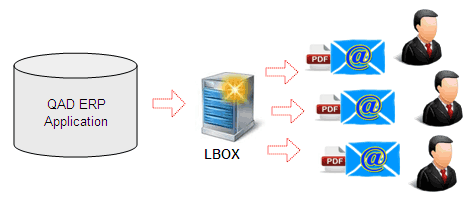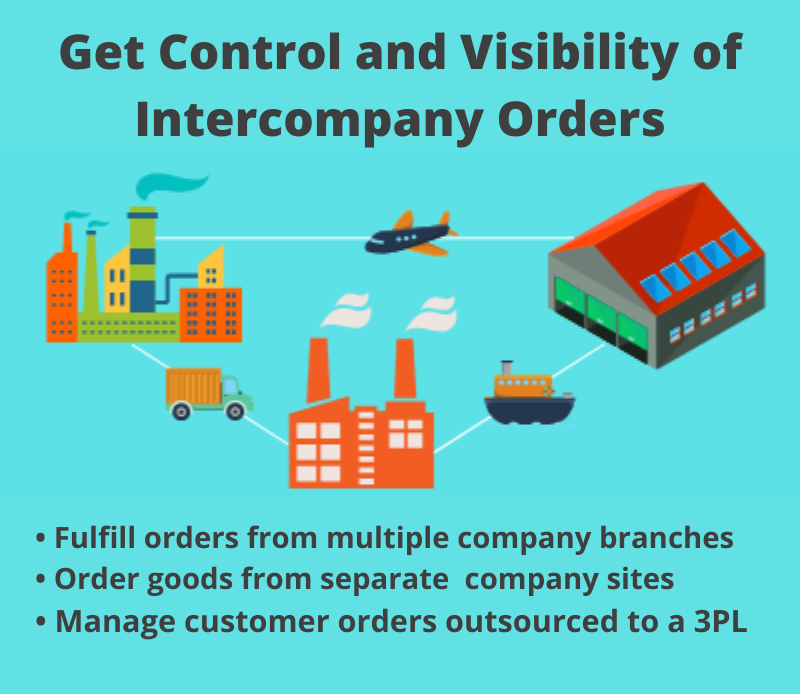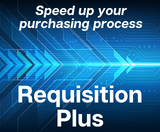Traditionally QAD users would print Supplier Schedules onto paper and then scan to email or FAX them to suppliers individually, one by one. This is very labor intensive process, especially when you have a few hundred suppliers.
Now you can automate the entire process of generation and distributing supplier schedules with the use of LBOX software.
This article takes you through the steps required to automate this process all by yourself, without hiring QAD consultants, without large investments. In fact you can download and try LBOX for free for a couple of months. Note: it is assumed you possess some limited technical skills.

You will not only save on labor effort but also decrease the use of paper, printer toner, etc. So, you have nothing to lose except for your lack of productivity.
The new automated process will run in batch mode (or manually if you want to) generating and emailing Supplier Schedules in the form of PDF attachments. The program sends also a copy of outbound emails to appropriate buyer, as well as to an “administrator” email address, if set, and saves PDF copies of the schedules to company’s file server. So all outbound schedules remain handy, within your reach, whenever you need them, but in electronic form of PDF or email messages in your MS Outlook.
Note that other processes such as Customer Statement print, Sales Order Confirmation, etc, can be enabled in similar manner. Enabling auto-invoicing in QAD with LBOX.
Step 1. Install LBOX as per installation instruction outlined here. Follow the instruction and make sure LBOX is capable of creating PDF files from QAD reports or print forms.
Step 2. Make sure LBOX email feature is working properly. This section explains what to do.
Step 3. To implement Auto-Schedules for Suppliers, you need to understand the process first.
Most likely, not all your suppliers would like getting schedules via email; however as you start offering this service, more and more will sign up.
A) Supplier email address will be stored in vd__chr04 field of vd_mstr (vendor master) table in QAD; this can be a comma delimited email address list, if more than one person needs to be notified. If vd__chr04 value is blank, it means that the supplier does not want to receive Schedules via email, but prefers them to be sent via snail mail or FAX.
You can create a simple maintenance program and place it to QAD menu to maintain the list. Our program source is here. Feel free to modify to meet your needs.
To set-up supplier’s buyer’s email address, use 36.2.13 Generalized Codes Maintenance, like this:

Field Name: SschedEmail
Value: [buyer code]
Comments: [email address, can be comma delimited list]
To set-up an “administrator” email address, use 36.2.13 Generalized Codes Maintenance, like this:

Field Name: SschedEmail
Value: ToAdministrator
Comments: [email address, can be comma delimited list]
B) QAD menu 5.5.3.8 Schedule Print program needs to be modified. You will have 2 versions of this program, one is your original 5.5.3.8 Schedule Print and the second is the Auto-Schedule Print. Let’s assume, the second one will be installed into 5.5.3.28 menu. We will explain later what changes should be made to this program.
For now, we just outline the new process.
5.3.3.28 should always be run first, before the original 5.3.3.8. This way all Auto-Schedule suppliers will be printed first and marked as processed. 5.3.3.28 can be run in batch mode or interactively from QAD menu. Select LBOX PDF output, suitable for schedule form. See below how to do that.
Regular 5.3.3.8 program should be run after that. All the remaining suppliers will get the schedules the same way you send them today. This step remains intact.
C) Now, let’s review the changes to be made to your original 5.3.3.8, i.e. how to create 5.3.3.28 from 5.3.38. Below we are providing a sample source code we have developed for one of our clients. The program source is here.
We modified rsrp05.p program and its sub-programs of QAD 2010 SE and added some modifications there. See markers throughout the code /*MC01*/
In the nut shell, the purpose of the modification was to break the single print program output stream into a few smaller ones, where each stream is schedules for a single supplier.
The new printing program inserts one extra line to each output stream, with embedded email instruction to LBOX, vEmailTo, vEmailSubj, vEmailName, vEmailBody. Also, it inserts a command for LBOX to save the PDF file generated as Schedule-.pdf
LBOX receives output streams sequentially and emails them one by one per instruction. Suppliers receive personalized emails with schedules as PDF attachment.
D) Creating PDF Schedule form. Read this section to understand the process.
Text stream from QAD is merged with static PDF template. Use $LBOX2ws\LBOXSvr\32prn\pdf\company.doc and edit it in MS Word as a starting point. Alternatively, draw your own template in MS Word. Then convert it to PDF and place it to $LBOX2ws\LBOXSvr\32prn\pdf\. Make sure the resulting PDF template is light in size, recommended size is 20-40 Kbytes. Do not exceed 70-100 Kbytes. Do not use heavy graphics in there. Otherwise, email attachments will become large and since emails are sent sequentially, Auto-Schedules process will take longer time taking up your email server’s resources too.
This section explains how to adjust PDF page parameters.
E) Auditing outbound emails. There is a log file $LBOX2ws\emOutbound.log, which you can browse to see if emails have been sent successfully or rejected.
Similarly, Customer Statements can be automated or Payment Remittances, etc.
Contact us if any questions. Good luck and enjoy LBOX!




